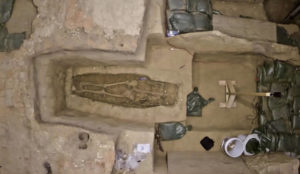
July 30, 1619 — It must have been a very auspicious occasion for the newly established land-owning settlers when Governor George Yeardley stepped into the church for the very first meeting of the Virginia General Assembly at Jamestown. Months before, while still in England, he was appointed by the King to succeed Lord De La Warr who, to everyone’s surprise, had died at sea on a return voyage to the young but burgeoning Virginia colony. For extra measure, the King knighted Yeardley, had him provisioned to set sail, and ensured him detailed instructions from the Virginia Company to institute a comprehensive body of reforms. Those reforms would establish the rule of law based on English precedent in the home country, protect the individual rights and private property of the new Virginia landowners, and establish a General Assembly of representatives (consisting of his four councilors and 22 burgesses selected from the settlements along the James River) who would look out for the interests of the colonists.
For the untested frontier of Virginia and the New World, this was akin to a grand experiment in democracy, and deemed necessary to ensure the continuing development and prosperity of a fledgling colony that, just nine years before, was on the brink of collapse. By 1619, however, Jamestown had expanded well beyond its original Fort, even sporting well-appointed homes of gentlemen planters, surrounded by new plantations that defined the foundations of Virginia’s embryonic economic prowess as a tobacco-exporting powerhouse. Although Yeardley and his Virginia Company instructors were not fully aware at the time of the import of the first assembly, it was unique, constituting the seed of democracy in the Western Hemisphere.
It was appropriate that the first assembly convened in an early church structure built by the colonists. It was a comparatively spacious, single-room public structure, a 50-ft. by 20-ft. timber frame constructed over a brick and cobblestone foundation in 1617 when Deputy Governor Samuel Argall was still in control of the colony. This is small by today’s standards, but back then it was enough room for the first representatives to sit themselves comfortably into the “quire” (choir) space for six days during a hot summer.
The original church structure no longer exists. It was replaced over its remaining footprint by another church, this time constructed of brick beginning in 1639 and completed at the end of the 1640’s. Overall, the site has seen a succession of four different iterations, obscuring from sight all traces of the original timber frame structure of 1617, the building in which America’s first General Assembly convened.
Uncovering Lost Walls, and a Sensational Burial Find
It wasn’t until archaeologists began excavating within the church (now the Memorial Church, built in 1907 at the same location) in November of 2016 that excavators eventually uncovered the evidence defining the complete original dimensions and foundational features of the 1617 church. This included, among other discoveries, remnants of a clay and cobblestone wall foundation while excavating the northeast corner of the chancel area of the church, and a narrow line of a brick-capped clay and cobblestone wall foundation running north-south through the center of a unit being excavated in the old church tower at the south end of the currently standing Memorial Church. Given the excavations and research conducted to this point, and the historical record of the original 1617 church at this location, archaeologists concluded that they had finally discovered the eastern and western wall foundations of the 1617 church. Material evidence of all four walls of the church in which America’s first representative assembly had met in 1619 had not been completely destroyed.
___________________________
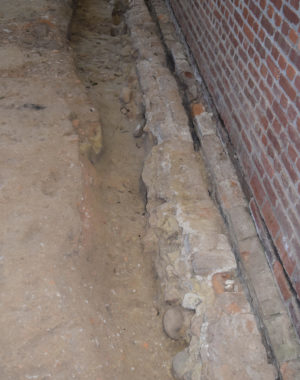
The brick, mortar and cobblestone foundation of the south wall of the 1617 church exposed.
But perhaps the most sensational find emerged while archaeologists were excavating within the area of the church that once featured the central east-west running aisle of the 1617 church. Here, evidence of a relatively large grave shaft was uncovered. Soil stain and multiple nails indicated that a hexagonal-shaped coffin running east-west had decayed away in this place long ago. Its shape was similar in style to those uncovered a few years before in the excavated footprint of the earlier, 1608 church (where John Rolfe and Pocahontas were married) discovered only a few yards away. In that excavation, the remains of Reverend Robert Hunt, Sir Ferdinando Wenman, Captain Gabriel Archer, and Captain William West, all known “movers and shakers” of the Jamestown settlement, were identified. They had been buried in the chancel area of the church. And like those earlier burials, the burial in what would have been the aisle of the 1617 church would have been a prime location for a prominent individual. Then, before excavating any further, the use of high-frequency GPR and the resulting data indicated the presence of bones and the orientation of a skeleton within the grave — something that had never been done before through GPR applications.
The aisle burial excavation was executed quickly, from Friday, July 21st, through Sunday, July 23rd. This was necessary because they had arranged to have Doug Owsley, renowned forensic anthropologist with the Smithsonian Institution’s Skeletal Biology Program, and his crew, participate in the examination and exhumation of the bones on Monday the 24th.
But the skeletal remains uncovered in the grave shaft were missing one critical element — the cranium. This was essential to identifying sex, origin, and facial characteristics. The cranium also contains two bones that are key to acquiring DNA samples: the petrous temporal. Understanding the evolution of the church’s material history (burial disturbance being common in 17th century churches due to space limitations), the archaeological team searched for a cranium among the church excavation finds of the past year. As it happened, there were three crania candidates, one of which had already been found in articulation with other skeletal remains, and two others. By successfully matching disarticulated teeth uncovered in the aisle burial with one of the remaining two skulls, the archaeologists were able to identify the skull that originally belonged to the skeleton in the aisle burial. They now had a skull to complete the forensic analysis, along with genomic (DNA) analysis, important for a definitive identification of the remains.
Who was this individual?
David Givens, Director of Archaeology with the Jamestown Rediscovery Historic Jamestowne Project, and his colleagues suggest this might be the remains of Governor Sir George Yeardley himself.
What are the clues that back them up?
Givens and his team point to several things. First, the remains were found in a grave shaft located in the central aisle, near the chancel area of the 1617 church footprint — a burial location that would be reserved for a very prominent individual during that time. Second, forensic analysis of the skeletal remains revealed that this individual was male, around 40 years old, was accustomed to light work (not heavy work as would be typical for a common laborer), likely spent considerable time on horseback and/or wearing armor, and consumed foodstuffs indigenous to this New World area, indicating considerable time spent in the New World. These characteristics would have been consistent with the historical profile of George Yeardley. Thirdly, a 32″ by 68″ distinctive Belgian black limestone tombstone (dubbed the “Knight’s Tombstone”, discovered years earlier at what would have been the southern entrance to the later 1640’s brick church that was constructed over the same site ), now thought to have been originally located where the center aisle burial of the 1617 church was discovered, features engraved depressions depicting a gentleman in armor typically for that of a knight. As noted earlier, Yeardley was knighted before he left England again for the Americas. But Yeardley was one of two knights who died during the time period of the second church (c.1617 to c.1639), the other being Lord Delaware, or Sir Thomas West, the colony’s first governor. Nonetheless, researchers suggest that the tombstone was likely Yeardley’s, as the will of his step-grandson, Adam Thorowgood II, notes a request that his tombstone be engraved similarly to that depicted on the Knight’s Tombstone.
__________________________
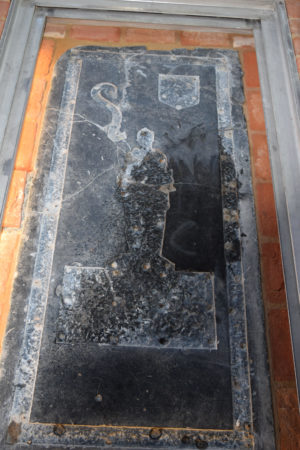
The Knight’s Tombstone
__________________________
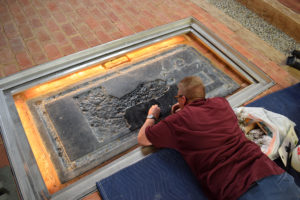
The Knight’s Tombstone undergoing tedious restoration.
__________________________
None of this, however, would prove to be definitive evidence attesting to the identification of the remains of George Yeardley without corroborating results from genomic, or DNA, testing. To this end, Givens and his team began collaborating with Dr. Turi King of the University of Leicester, the geneticist who previously directed genomic research to identify the remains of King Richard III in 2013. Teamed with experts from the FBI’s DNA Support Unit (DSU) laboratory, King and colleagues were able to extract enough DNA material from the remains to achieve a 75% recovery rate, which led to building a full DN sequence on the individual. While research and analysis continues, researchers suggest the possibility that the results could yield information about the individual as detailed as hair and eye color. But while the genomic research under her direction has progressed satisfactorily, the genealogical search needed to find the right living relative for the comparative DNA analysis has thus far proven to be a “sticky wicket”, as Givens phrased it. This is in part due to the fact that Yeardley’s mother was adopted, so tracing the lineage forward from her using mitochondrial DNA (a proven method long used by geneticists for such endeavors) would lead them nowhere. But tracing through his natural grandmother (mitochondrial), or his father or grandfather through Y-chromosome analysis could produce results once the right living relative could be identified through genealogical research. Enter here University of Leicester’s Kevin Schürer who, like King, was involved in the investigations to identify the remains of King Richard III. Brought in by Given’s team for his expertise in genealogical research, Schürer is endeavoring to test the recovered DNA against DNA from at least one relative in the direct line of descent from Yeardley. Thus far, Schürer has identified 26 female lines of descent four generations deep, and work continues.
Meanwhile, forensic analysis of the bones continued to reveal new results. Owsley and his Smithsonian team have been busy developing a full forensic profile of the remains, which will tell us more about the life that belonged to the bones before death. Moreover, Dr. Peter Quinn and Dr. Greg Maslow of the University of Pennsylvania, along with others from Penn Medical, the Penn Museum and Penn Dental, have examined the remains, resulting in observations that could reveal new facts that, if the bones prove definitively to be those of Yeardley, will tell us personal medical details untold by historical documents. According to these researchers, this man suffered from a crippling ailment: osteomyelitis—a severe and painfully worsening bone infection that paints a profile of a person in declining health at the end of his life.
__________________________
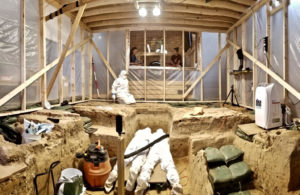
Panoramic view of the aisle burial excavation area. A sealed structure was built over the excavation area to reduce DNA contamination. The “tent” was positively charged with filtered air conditioning and all tools and equipment were sterilized prior to the dig. Excavators were donned in special suits for the same purpose. Courtesy Jamestown Rediscovery
__________________________
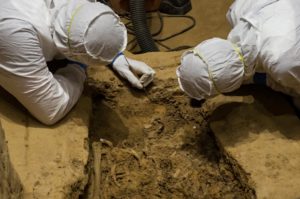
Director of Archaeology David Givens and Senior Staff Archaeologist Mary Anna Hartley carefully excavate maxillary incisors adhered to the first cervical vertebra of the skeleton.Using fine tools and techniques, excavating the delicate remains was a slow and meticulous process. Courtesy Jamestown Rediscovery
__________________________
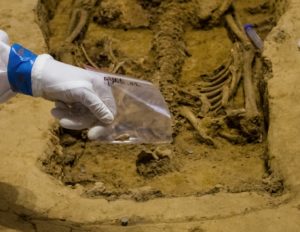
A tooth recovered from the individual (adhered to the first cervical vertebra). Teeth are critical for DNA analysis. Courtesy Jamestown Rediscovery
__________________________

Overhead view of excavators hard at work on the skeletal remains. Courtesy Jamestown Rediscovery
__________________________

Overhead view of the completely excavated skeletal remains. Notice the missing skull. Courtesy Jamestown Rediscovery
__________________________
Yeardley, Slavery, and More Burials
While Yeardley played a key role in establishing the first seeds of freedom and democratic governance in the New World, some irony or incongruity is not lost on the fact that he was also among the first ‘slaveholders’ in America. Ships arrived at Point Comfort (on the coast of present-day Virginia) in 1619, the very same year of the First General Assembly, unloading a human cargo of Africans for sale to early English planters who transported them to the newly founded English colony and its surrounding developing plantations (see the article, Digging the Roots of American Slavery). Yeardley, also a prominent Virginia planter, likely became the recipient of some of these new servants.
But were these first Africans actually slaves or something more akin to indentured servants who, after a period of time, were permitted to acquire their freedom and live independent lives? The probability is high that this may have been their status, as slavery as it was codified into law in the colonies decades later did not exist at that time in the form most familiar to American history. The first Africans’ experience nonetheless arguably laid the foundation upon which the institution of slavery was born and flourished through the subsequent decades. Thus began the story of the great American paradox, a reality that has haunted American society since its inception.
Beginning in 2017, Givens and his team began excavating an area within easy walking distance east of the original James Fort location in Jamestown. Historically, it is thought to contain evidence for the property of Captain William Pierce, among those of other wealthy planters. Like his peers, Pierce was an influential planter and merchant who built an impressive house within the newly developed town east of the James Fort area (known as New Towne) in the wealthy section known as ‘Back Street’. He was also the owner of a servant known from a 1624 muster (census) that recorded the presence of 21 Africans. One of them, a female African servant referred to as ‘Angela”, was documented as being connected to the Pierce household. Based on other historical documents, Angela is presumed to have been among the first group of Africans to arrive in Jamestown in 1619. The excavation has thus acquired the nick-name as the “Angela site”, and has been a focus of Givens’ research and investigations to define the greater James City that sprawled east of the original James Fort location. He has been working in collaboration with the National Park Service to this end.
What have they uncovered?
“A lot of people think we’re looking for Angela,” said Givens. “But that’s not what we’re doing. We’re looking at the contextual — the world in which Pierce was an actor [and by extension Angela].” And that context is slowly coming to light. Artifacts and other structural evidence of early 17th century occupation has emerged. Evidence of early 17th century posts have been uncovered at the site. Archaeologists interpret the finds as features of a gable end or addition to a house structure. But archaeology is a slow, painstakingly deliberate process, and the footprint of Jamestown in this area is exceedingly complex, given the continuous building, construction destruction and re-building, and turnover of occupants in succeeding generations of early Virginians who made their lives here. Moreover, the application of remote sensing techniques, such as LiDAR, is beginning to present some surprises, causing archaeologists to question the precise location of some town elements, such as the colonial road and other town structures that may potentially be found, possibly shifting the long-standing interpretation of the James City landscape.
GPR applications have also revealed another head-scratching development. Several burials were discovered. But these burials did not fit the pattern seen elsewhere at Jamestown — disparate, scattered in a corner lot, they defied the placement normally observed with families, lineages, or other groups on the historical landscape of Jamestown. Givens knew they had to be early burials, as no materials datable to later time periods were present at the burial locations.
This was something the archaeologists had not previously encountered. “We can’t ignore the fact that, spatially, we’re seeing something new and unique,” says Givens.
Popular Archaeology asked Givens if he had any thoughts about who these people may have been. “Indentured servants, perhaps,” he said. This could explain the nature of the burials.
Could they be some of the first Africans? It would be difficult to know without actually excavating the burials, and that would likely not happen soon, if at all, as permissions and approvals must be obtained before initiating any excavation of skeletal remains discovered in a grave site.
For now, they remain points on a newly emerging archaeological landscape.
_________________________
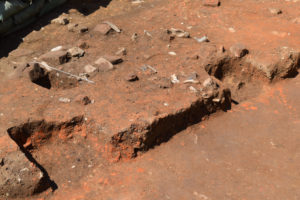
Above and below: Features emerging in the excavations at the ‘Angela site’ as of late April, 2019.
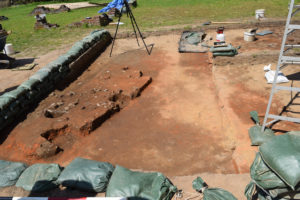
_________________________
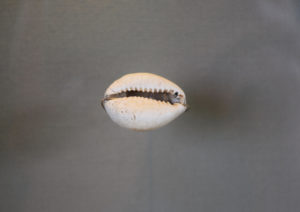
Cowrie shells had monetary and spiritual value to enslaved Africans during the 17th and 18th century in the British colonies. This cowrie shell was excavated at the ‘Angela site’ at Jamestown.
_________________________





